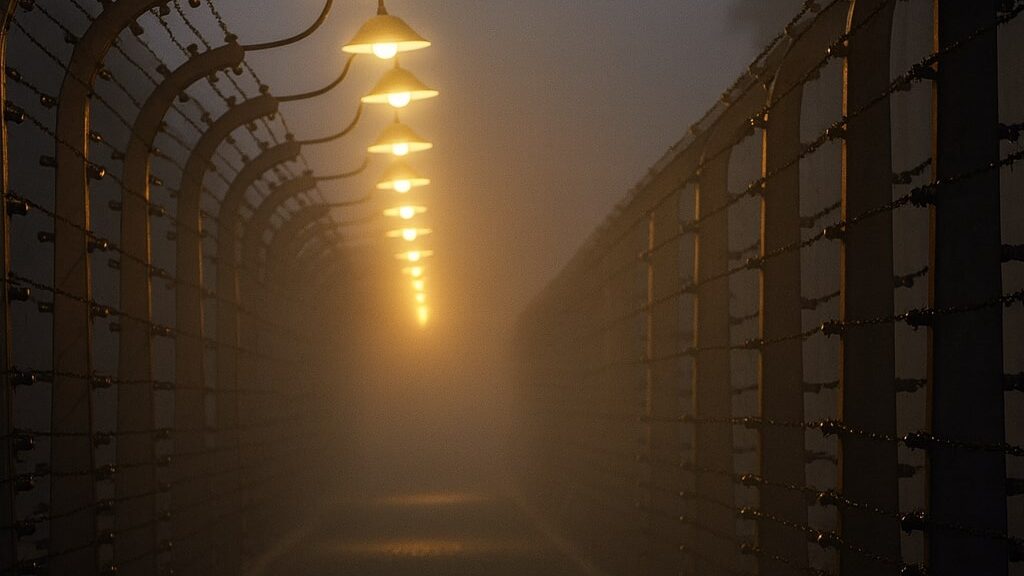Auschwitz resistance is the term used for clandestine networks, escapes and acts of solidarity inside the camp complex. This article explains what resistance meant in practice – how prisoners organised, what risks they faced and why the 1944 Sonderkommando revolt matters. For origins see The Origins of Auschwitz, for the camp layout see The Structure of the Auschwitz Complex, and for forced labour see Auschwitz Monowitz and IG Farben.
On this page: Auschwitz resistance – what it meant · Underground networks and help from outside · Escapes – selected cases · The Sonderkommando revolt (1944) · Risks and reprisals · Sources and documentation
Authoritative overviews: Auschwitz-Birkenau State Museum · United States Holocaust Memorial Museum
Auschwitz resistance – what it meant
In a concentration and extermination camp, resistance ranged from preserving dignity and mutual aid to gathering evidence and sabotaging work. The aim was survival, solidarity and – when possible – undermining the machinery of persecution and murder. Auschwitz resistance took many forms because conditions and opportunities differed between Auschwitz I, Auschwitz II-Birkenau and Auschwitz III-Monowitz.
Understanding the map and functions of each part helps place actions in context – see the Auschwitz map for orientation and distances between key sites.
Underground networks and help from outside
Prisoners built clandestine networks to share information, hide documents and organise aid. Contacts with civilians outside the camp – though rare and dangerous – helped smuggle messages, medicines and, at times, civilian clothing. Such efforts relied on trust and secrecy; discovery meant collective punishment that could affect entire blocks or labour details.
Resistance also included gathering evidence about crimes. Fragments of documents, sketches and testimonies were preserved despite searches and reprisals. Where possible we link to case studies in separate articles so readers can follow specific stories from plan to outcome.

Escapes – selected cases
Witold Pilecki – infiltration and reports (1940-1943)
In September 1940 Witold Pilecki entered Auschwitz under a false identity to build an underground organisation (ZOW). He coordinated mutual aid, gathered information and sent reports beyond the camp. In April 1943 he escaped and later produced accounts that remain key sources on daily life, structures and risks faced by prisoners.
Read more: Witold Pilecki in Auschwitz
20 June 1942 – escape by car in SS uniforms
Four Polish prisoners – Kazimierz Piechowski, Stanisław Gustaw Jaster, Józef Lempart and Eugeniusz Bendera – seized an SS car, put on stolen uniforms and drove out through the main gate. The plan relied on precise knowledge of routines and quick decisions at checkpoints. It became one of the best-known escapes and helped carry information beyond the wire.
Read more: The 20 June 1942 escape
Vrba and Wetzler – the Auschwitz Protocols (April 1944)
In April 1944 Rudolf Vrba and Alfred Wetzler escaped from Birkenau and compiled a detailed report describing transports, selections and killing facilities. Circulated in Slovakia and Switzerland and among Allied contacts, the ‘Auschwitz Protocols’ shaped how events in the camp were understood outside. The case shows how escape and documentation worked together.
Read more: Vrba – Wetzler and the Auschwitz Protocols
Jerzy Bielecki and Cyla Cybulska – July 1944
In July 1944 Polish political prisoner Jerzy Bielecki used a stolen SS uniform and a forged escort pass to lead Cyla Cybulska, a Jewish prisoner, out through the main gate. Underground contacts and help from civilians enabled hiding and onward movement. Their experience illustrates the role of documents, timing and solidarity in making an escape possible.
Read more: Bielecki – Cybulska escape
Mala Zimetbaum and Edek Galiński – attempted escape (1944)
In 1944 Mala Zimetbaum and Edward (Edek) Galiński attempted to escape from Birkenau. They were captured and executed after severe reprisals. Remembering such attempts matters: resistance was not only about successes but also about decisions taken under extreme risk and their human cost.
The Sonderkommando revolt (1944)
In October 1944 members of the Sonderkommando – forced to work in the crematoria at Birkenau – rose in revolt. They damaged parts of the killing infrastructure before SS units crushed the uprising. The revolt was a desperate act born of extreme conditions and remains one of the best documented episodes of Auschwitz resistance.
The revolt is inseparable from Birkenau’s role in deportations, selections and killing – see the Auschwitz map for the layout of sectors and crematoria.
Risks and reprisals
Any act of resistance exposed prisoners and bystanders to severe reprisals. Punishments included beatings, executions and collective penalties. The threat of retaliation shaped decisions and limited what was possible at any given moment. This is why small acts – preserving evidence, aiding a single prisoner, transmitting a message – could still be historically significant.
Sources and documentation
What we know about Auschwitz resistance comes from post-war investigations, surviving documents, photographs and testimonies of prisoners and witnesses. Where precise totals or names are uncertain, historians use carefully established estimates and contextual evidence based on institutional research.
Methodology note: this article draws on institutional research and published testimonies. Where exact figures are impossible, we indicate ranges and explain context in linked articles.
Read next
The Origins of Auschwitz · The Structure of the Auschwitz Complex · Auschwitz Monowitz and IG Farben
Victims and Survivors of Auschwitz · Liberation of Auschwitz and the Memory of 27 January
